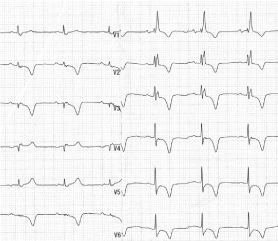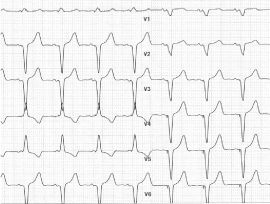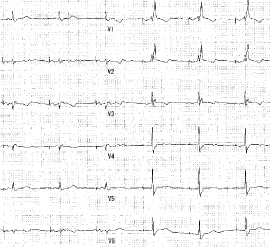
Clinical Image
Austin J Clin Cardiolog. 2015; 2(2): 1041.
T-wave Inversion after a Pacemaker Implantation
Aizawa Y1,2*, Tanaka T2, Komura S2 and Funazaki T2
¹Department of Cardiology, Keio University School of Medicine, Tokyo, Japan
²Department of Cardiology, Saiseikai Kawaguchi General Hospital, Saitama, Japan
*Corresponding author: Yoshiyasu Aizawa, Department of Cardiology, Keio University School of Medicine, 35 Shinanomachi, Shinjuku-ku, Tokyo 160- 8582, Japan
Received: December 03, 2014; Accepted: September 10, 2015; Published: October 08, 2015
Clinical Image
An 80-year-old female was implanted with dual chamber pacemaker due to symptomatic sick sinus syndrome. Her preoperative ECG showed complete right bundle-branch block with T-Wave Inversion (TWI) only at V1-3 leads. (A) Her ECG showed global T-wave inversion one week after pacemaker implantation (B). The patient was asymptomatic and echocardiography revealed no evidence of myocardial ischemia.

Figure A: Her ECG showed global T-wave inversion one week after
pacemaker implantation.

Figure B: The patient was asymptomatic and echocardiography revealed no
evidence of myocardial ischemia.

Figure C: The direction of TWI was consistent with that of paced QRScomplex
(B, C) and disappeared one month later.

Figure D: Clinicians should rule out myocardial ischemia when TWI develops
but need to aware of this curious phenomenon to prevent unnecessary
examination for differential diagnosis.
Cardiac memory has been known for many years [1]. It is a unique phenomenon of electrical remodeling following periods of abnormal ventricular activation including ventricular pacing, intermittent left bundle-branch block, and pre-excitation due to WPW syndrome [2]. This patient was performed ventricular pacing by short A-V interval for several days after pacemaker implantation. (C) The direction of TWI was consistent with that of paced QRS-complex (B, C) and disappeared one month later (D). Clinicians should rule out myocardial ischemia when TWI develops but need to aware of this curious phenomenon to prevent unnecessary examination for differential diagnosis.
References